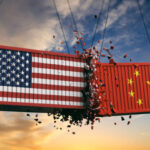
Global supply chains are once again under pressure as the United States and China introduced reciprocal port fees, marking the latest escalation in a trade conflict that has already roiled markets for months. The new fees target ships carrying cargo to ports in the opposing country, effectively raising shipping costs for multinational exporters and importers.
China’s Ministry of Commerce announced the measure on Monday, stating that it was a “defensive response to U.S. tariff and fee policies” while keeping the door open for negotiations. The U.S. Department of Commerce confirmed its own fees, calling them “necessary to protect domestic economic interests.”
Shipping experts warn that the fees could create a ripple effect across global trade. Container freight rates have already risen 8–10% in the past week, with small- and medium-sized exporters particularly vulnerable. Economists estimate that if the standoff continues, global trade growth could slow by up to 0.3% in 2026, affecting both developed and emerging economies.
Ports in Singapore, Rotterdam, and Los Angeles are preparing for potential congestion as shipping companies reroute vessels to avoid the fees. “It’s a domino effect — even markets not directly involved in the dispute will feel higher costs and delayed shipments,” said Jens Hansen, a maritime logistics consultant based in Hamburg.
For India, the implications are mixed. While some sectors may benefit from trade diversion, companies reliant on Chinese imports could face higher costs, particularly in electronics, machinery, and chemicals. Export-oriented industries, such as textiles and coatings, may need to negotiate alternative supply routes or pass on costs to customers.
Financial markets reacted with caution. Asian stock indexes dipped 0.5–0.7% amid fears of escalating trade friction. Commodity prices also fluctuated, with crude oil rising slightly due to anticipated shipping disruptions and logistical bottlenecks.
Industry Insight – Industrial Front:
The U.S.–China maritime fee standoff serves as a wake-up call for Indian manufacturers and exporters. Industrial Front advises companies to diversify supply chains, explore regional ports, and consider inventory hedging strategies. In the long term, India’s geographic advantage and stable regulatory environment may attract global manufacturers seeking alternatives to China-centric supply routes.
